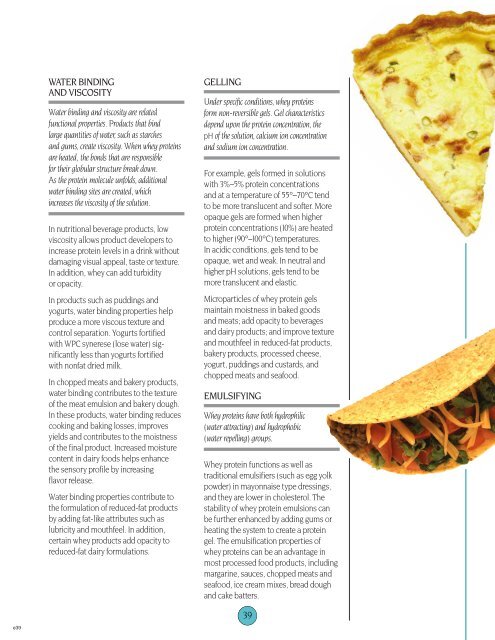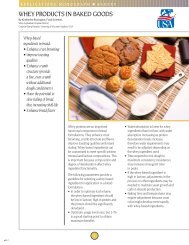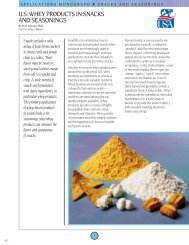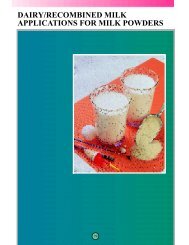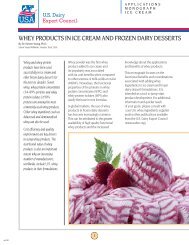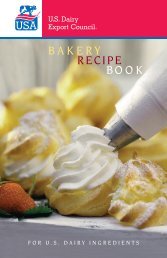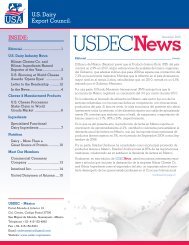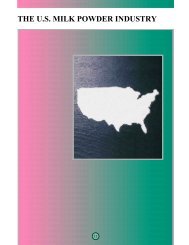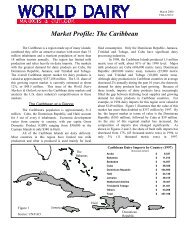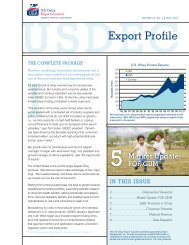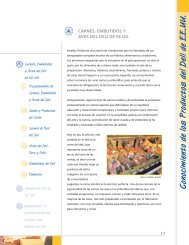nutritional and functional properties of whey and lactose
nutritional and functional properties of whey and lactose
nutritional and functional properties of whey and lactose
Create successful ePaper yourself
Turn your PDF publications into a flip-book with our unique Google optimized e-Paper software.
WATER BINDING<br />
AND VISCOSITY<br />
Water binding <strong>and</strong> viscosity are related<br />
<strong>functional</strong> <strong>properties</strong>. Products that bind<br />
large quantities <strong>of</strong> water, such as starches<br />
<strong>and</strong> gums, create viscosity. When <strong>whey</strong> proteins<br />
are heated, the bonds that are responsible<br />
for their globular structure break down.<br />
As the protein molecule unfolds, additional<br />
water binding sites are created, which<br />
increases the viscosity <strong>of</strong> the solution.<br />
In <strong>nutritional</strong> beverage products, low<br />
viscosity allows product developers to<br />
increase protein levels in a drink without<br />
damaging visual appeal, taste or texture.<br />
In addition, <strong>whey</strong> can add turbidity<br />
or opacity.<br />
In products such as puddings <strong>and</strong><br />
yogurts, water binding <strong>properties</strong> help<br />
produce a more viscous texture <strong>and</strong><br />
control separation. Yogurts fortified<br />
with WPC synerese (lose water) significantly<br />
less than yogurts fortified<br />
with nonfat dried milk.<br />
In chopped meats <strong>and</strong> bakery products,<br />
water binding contributes to the texture<br />
<strong>of</strong> the meat emulsion <strong>and</strong> bakery dough.<br />
In these products, water binding reduces<br />
cooking <strong>and</strong> baking losses, improves<br />
yields <strong>and</strong> contributes to the moistness<br />
<strong>of</strong> the final product. Increased moisture<br />
content in dairy foods helps enhance<br />
the sensory pr<strong>of</strong>ile by increasing<br />
flavor release.<br />
Water binding <strong>properties</strong> contribute to<br />
the formulation <strong>of</strong> reduced-fat products<br />
by adding fat-like attributes such as<br />
lubricity <strong>and</strong> mouthfeel. In addition,<br />
certain <strong>whey</strong> products add opacity to<br />
reduced-fat dairy formulations.<br />
GELLING<br />
Under specific conditions, <strong>whey</strong> proteins<br />
form non-reversible gels. Gel characteristics<br />
depend upon the protein concentration, the<br />
pH <strong>of</strong> the solution, calcium ion concentration<br />
<strong>and</strong> sodium ion concentration.<br />
For example, gels formed in solutions<br />
with 3%–5% protein concentrations<br />
<strong>and</strong> at a temperature <strong>of</strong> 55°–70°C tend<br />
to be more translucent <strong>and</strong> s<strong>of</strong>ter. More<br />
opaque gels are formed when higher<br />
protein concentrations (10%) are heated<br />
to higher (90°–100°C) temperatures.<br />
In acidic conditions, gels tend to be<br />
opaque, wet <strong>and</strong> weak. In neutral <strong>and</strong><br />
higher pH solutions, gels tend to be<br />
more translucent <strong>and</strong> elastic.<br />
Microparticles <strong>of</strong> <strong>whey</strong> protein gels<br />
maintain moistness in baked goods<br />
<strong>and</strong> meats; add opacity to beverages<br />
<strong>and</strong> dairy products; <strong>and</strong> improve texture<br />
<strong>and</strong> mouthfeel in reduced-fat products,<br />
bakery products, processed cheese,<br />
yogurt, puddings <strong>and</strong> custards, <strong>and</strong><br />
chopped meats <strong>and</strong> seafood.<br />
EMULSIFYING<br />
Whey proteins have both hydrophilic<br />
(water attracting) <strong>and</strong> hydrophobic<br />
(water repelling) groups.<br />
Whey protein functions as well as<br />
traditional emulsifiers (such as egg yolk<br />
powder) in mayonnaise type dressings,<br />
<strong>and</strong> they are lower in cholesterol. The<br />
stability <strong>of</strong> <strong>whey</strong> protein emulsions can<br />
be further enhanced by adding gums or<br />
heating the system to create a protein<br />
gel. The emulsification <strong>properties</strong> <strong>of</strong><br />
<strong>whey</strong> proteins can be an advantage in<br />
most processed food products, including<br />
margarine, sauces, chopped meats <strong>and</strong><br />
seafood, ice cream mixes, bread dough<br />
<strong>and</strong> cake batters.<br />
e39<br />
39


